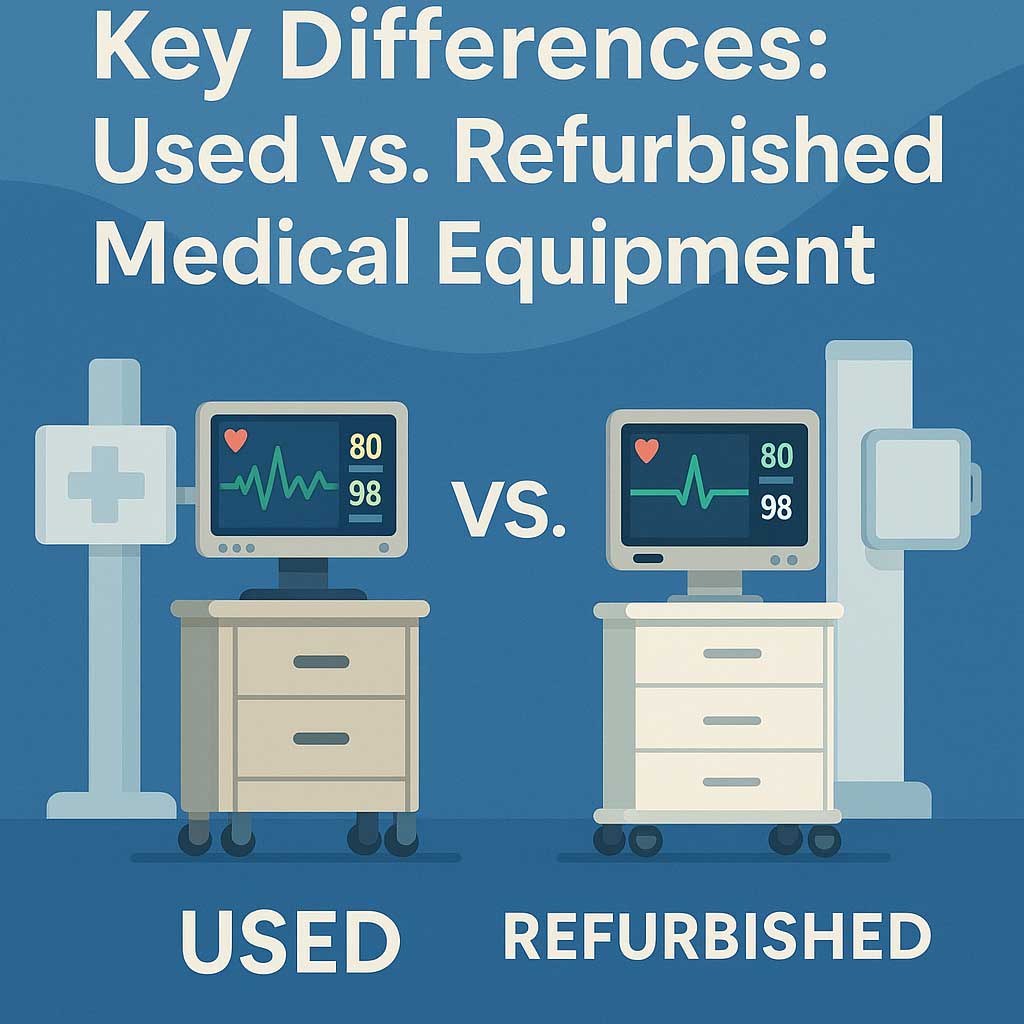When it comes to equipping a medical facility on a budget, two terms often surface: used and refurbished medical equipment.
While they may seem interchangeable, understanding the difference between the two is essential for making safe, cost-effective, and compliant purchasing decisions. In this guide, we break down the key differences, benefits, and risks of each to help you make an informed choice.

What Is Used Medical Equipment?
Used medical equipment refers to any previously owned medical device sold in its current condition. These items are often sold ”as-is” without undergoing major inspection, repair, or certification. Common sources include hospital surplus, private resellers, or direct liquidation sales.
Common examples of used equipment:
- Hospital beds and exam tables
- Basic monitoring systems
- Outdated or decommissioned devices
What Is Refurbished Medical Equipment?
Refurbished medical equipment, while also previously owned, has been professionally restored to like-new condition. This process includes deep cleaning, part replacement, recalibration, testing, cosmetic repair, and certification. Most refurbished equipment is sold with a limited warranty and detailed documentation.
Common examples of refurbished equipment:
- Ultrasound machines
- Patient monitors with updated firmware
- Defibrillators and imaging systems
Key Differences Between Used and Refurbished Equipment
| Aspect | Used Equipment | Refurbished Equipment |
|---|---|---|
| Condition | Sold as-is, with visible wear and potential faults | Restored to like-new condition |
| Testing & Inspection | Minimal or no testing | Fully inspected, repaired, and tested |
| Warranty | Usually no warranty | Warranty included (3–12 months typical) |
| Price | Lower upfront cost | Higher, but with added value and reliability |
| Compliance | May not meet current safety standards | Updated to comply with regulations |
| Ideal For | Non-critical use, research labs, parts salvage | Clinical use, diagnostics, patient-facing equipment |
Pros and Cons of Used Equipment
✅ Pros
- Lower cost than refurbished or new
- Available quickly from private sellers
- Good for low-risk applications
⚠️ Cons
- Uncertain performance and lifespan
- No warranty or support
- Risk of regulatory non-compliance
Pros and Cons of Refurbished Equipment
✅ Pros
- Certified performance and safety
- Warranties and technical support available
- Suitable for clinical and patient care
⚠️ Cons
- More expensive than used
- Availability depends on certified vendors
When to Choose Used vs. Refurbished
Here’s a quick guideline:
- Choose Used Equipment if you're buying for training, research labs, or non-patient environments and have in-house technical expertise.
- Choose Refurbished Equipment if you're equipping a clinical practice, need warranty protection, or must meet safety regulations.
Tips for Buying Safely
- Verify the Seller: Work with reputable distributors or certified refurbishers.
- Request Documentation: Ask for service history, compliance certificates, and testing reports.
- Check for Warranty: Especially with refurbished units, ensure warranty terms are clearly stated.
- Inspect Before Purchase: If possible, physically inspect or request a live demo of the equipment.
- Understand Local Regulations: Make sure your purchase is legal and compliant with local health standards.
Conclusion
Understanding the difference between used vs. refurbished medical equipment is critical for healthcare professionals making equipment decisions. Used devices may offer savings but come with risks. Refurbished equipment, while slightly more expensive, provides greater safety, performance, and peace of mind — especially when working with patients.
Always assess your clinical needs, budget, and risk tolerance before making a purchase.
